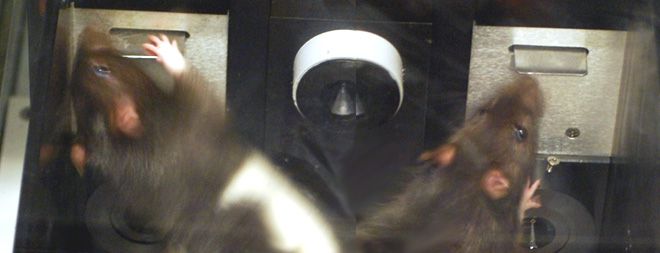Tracking Uncertainty's Origin in the Brain

(ISNS) -- A team of mind readers can now pinpoint exactly when a rat feels uncertain about its choices, simply by measuring its brain activity.
Doubt, they've discovered, creeps into the mind slowly. It starts with a few nerve cells near the front of the brain that get themselves into a tizzy. More and more cells join in, until a line is crossed and the mental maelstrom shakes up established patterns of brain activity -- allowing rats, and possibly humans as well, to question their old beliefs about the world and explore new options, researchers report in the October 5 issue of the journal Science.
"When your environment changes, you want to be able to reevaluate the world," said Alla Karpova, a neuroscientist at the Howard Hughes Medical Institute’s Janelia Farm campus in Ashburn, Va. "We have seen an abrupt change in neural activity at a moment when an animal seems to abandon a previously held belief."
Karpova studies the medial prefrontal cortex, a brain region that's thought to guide decisions by weighing the good and bad outcomes of past choices. Levels of activity in a probably analogous part of the human brain can predict how well people do at games that require learning from past experiences, one group of researchers reported in 2007. Macaque monkeys with brain damage in this area can still use their most recent mistakes to guide their choices. But they can't draw on lots of choices made over time, an ability that's important for picking the best places to search for food in the wild.
Uncertainty plays an important role in making such decisions, helping to balance beliefs drawn from previous experiences against changing conditions. A fisherman who never doubts a favorite spot that has yielded good results in the past may miss the fact that the fish have moved on, for instance.
To tease out how the brain switches from certainty to uncertainty, the Janelia team set up a vending machine of sorts for laboratory rats. One noise from the contraption signaled rats to pull a lever on the left, and another noise the right. Sometimes, but not always, the machine spat out a bit of food as a reward for pulling the appropriate lever.
Over time, the rats figured out that the game was rigged; the left lever yielded treats more often than did the right. After each creature learned to favor the left, its medial prefrontal cortex showed a stable pattern of electrical impulses, as measured by electrodes inserted directly into the brain. Cells in the region behaved like a pack of marathon runners, firing at different rates but each maintaining its own relatively steady pattern.
Sign up for the Live Science daily newsletter now
Get the world’s most fascinating discoveries delivered straight to your inbox.
Then the researchers swapped the character of the levers, making the right one became the better option. The rats didn't spot the switcheroo or change their behavior immediately. But cells in the medial prefrontal cortex started to lose their steady patterns, speeding up or slowing down unpredictably. Eventually, hundreds of cells were firing out of whack, crossing a threshold that resets the network, said Karapova, and allows the brain to be certain it should be uncertain.
This reset coincided with a change in behavior, as the rats spent less time at the left lever and more time exploring the right. Like a diner who has realized that his favorite restaurant has changed cooks, the rodents noticed that something was amiss. Their brain networks would stabilize again -- and find a new pattern -- only after the creatures accumulated enough evidence to decide to favor the right lever.
"This way of monitoring a pattern of activity for changes across the whole group of neurons is something that few studies have done previously," said Matthew Rushworth, a neuroscientist at the University of Oxford. "It shows a change when the animals switch from exploiting a choice to exploring what else might be out there in the environment."
Being able to spot the onset of uncertainty, though, doesn't necessarily reveal how exactly the rats eventually change their minds - or what information they use to do so. The details of what an animal believes and how those beliefs get shaken up remain obscure, hidden in the neural code of the brain's electrical impulses.
"Now we can see when the neural code changes and when an animal's beliefs change," said Oxford neuroscientist Tim Behrens. "This might give us an insight into understanding how those beliefs got coded in the first place, which is basically the biggest challenge in neuroscience right now."
Devin Powell is a freelance science journalist based in Washington, D.C. His stories have appeared in Science, Science News, New Scientist, Wired and many other outlets, including The Best American Science Writing 2012 anthology.
Inside Science News Service is supported by the American Institute of Physics.
Most Popular

